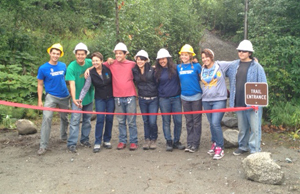
Members of the Student Conservation Association’s (SCA) 2016 CIRI Youth Crew this summer tackled a month-long environmental challenge on Alaska’s Kenai Peninsula that met a critical habitat need and improved access for visitors to the Kenai National Wildlife Refuge (KNWR).
The mission of the SCA is to build the next generation of conservation leaders and inspire lifelong stewardship of our environment and communities by engaging young people in hands-on service to the land. This nationwide program was founded in 1957; crews have been active in Alaska since the mid-1980s.
Instrumental in shifting the focus of the Alaska program was former CIRI president and CEO Margaret “Margie” Brown, who serves on both the CIRI and SCA Board of Directors. “Six years ago, our Anchorage office opened,” said Eileen Kazura, SCA Alaska program manager. “Prior to that, opportunities [in Alaska] were open to anyone, and most individuals came to us from the Lower 48. Margie worked with us to provide opportunities specifically for Alaskan and Alaska Native youth.”
In 2010, SCA fielded one Alaska crew of six; in 2016, six teams were fielded in locations throughout the state. “It shifts year to year depending on funding levels, but the past few summers we’ve had anywhere from 40 to 60 participants,” Kazura said. “The program has really grown.”

CIRI has worked with SCA since 2010, sponsoring crews of Alaska Native youth ages 15-19 each summer. 2016 funding was a joint effort between CIRI and KNWR. This summer, the CIRI Youth Crew constructed a 400-foot turnpike at Marsh Lake, a previously inaccessible body of water near the town of Sterling. The team of six was aided by two SCA crew leaders.
The project resulted from 2015’s destructive Card Street fire, which scorched 9,000 acres. Refuge staff realized that a proposed fire break – a strip of land on which flammable vegetation and debris have been removed so it can act as a barrier in the event of a wildfire – aligned with an existing plan to build a trail to Marsh Lake.
A bulldozer initially cut a three-mile line through spruce and birch forest from the road to the Marsh Lake area. However, the final 400 feet to the edge of the lake remained undisturbed wetland. The CIRI Crew worked to build a turnpike to elevate the final 400 feet of trail and complete access to the lake. The refuge anticipates high visitation and use of this trail due to its easy access point off the Sterling Highway.
The CIRI Crew lived and worked for four weeks in the KNRW, placing logs, hauling gravel and dirt using backpacks and buckets, then re-vegetating and naturalizing the surrounding area. The rainy weather in July and August presented the team with a variety of challenges, primarily in the form of mud and muck in which they had to move many heavy logs. Near the end of the crew’s time, particularly heavy rains drew out the final process of filling the turnpike with fill dirt, and the team and refuge staff began worrying they might not have time to complete the project.
Thankfully, two days of clear skies enabled the team to end on a high note, fully completing the turnpike project and exceeding original production goals. This summer, Margie Brown, CIRI’s Jason Brune, senior director, Land and Resources, and CIRI summer intern Ravynn Nothstine visited the crew on one of its final work days. “It’s really fun to learn from and interact with people from CIRI, and we thank the corporation for its support,” Kazura said. “It’s important for people to know this program could not have gotten off the ground without CIRI.”
For more information about SCA’s Alaska program, visit www.thesca.org/serve/program/alaska-regional-crews.



